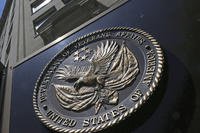The Air Force's top man appeared worn out Thursday when he took the podium at a downtown Washington D.C. Hilton. Fighting a cold, Air Force Chief of Staff Gen. Norton Schwartz asked for a throat lozenge from his assistant as he started his speech, hosted by a prominent D.C. think-tank, 30 minutes late.
Schwartz quickly apologized for his tardiness, explaining how his schedule got pushed back due to a blitz from two Congressional delegations wanting an explanation to the cuts the leadership laid out last week to Air Force's force structure and the Air National Guard.
It's one of many trips the Air Force four-star will surely make to Capitol Hill in this budget cycle, as the Guard has plenty of Congressional allies. Those champions will want an explanation to why four of the six combat coded tactical air squadrons cut were Guard and Guardsmen made up more than half of the 10,000 airmen chosen for the drawdown.
Schwartz launched into his justification for targeting the Guard for the brunt of the cuts. He said the Guard has grown in recent years when the service's active component has shrunk. The Guard and Reserve make up 35 percent of the Air Force compared to 25 percent in 1990. Guard and Reserve units also own a larger portion of aircraft growing from 23 percent to 28 percent since 1990.
Schwartz explained to the crowd, still nibbling on remnants of boxed lunches, how he had the support of the Guard and Reserve leadership. He pointed to a column printed in Air Force Times signed by himself, Reserve Chief Lt. Gen. Charles Stenner and Air Guard Director Lt. Gen. Harry "Bud" Wyatt, explaining how the three chose the cuts together.
Critiques haven't fallen on deaf years in Schwartz's Pentagon office. He's heard the cries from concerned airmen worried about the death of the A-10. The service will retire 102 of the 348 A-10s in the service's fleet as part of this round of cuts. Frustration rose into the chief's voice when he explained how those retirements do not signal a reduction in the service's commitment to close air support.
"The A-10 is a noble airplane, but one should not accept the hype that the Air Force is moving away from CAS," he said. "Nothing could be further from the truth."
Schwartz eagerly spoke about the next generation bomber, a program that looked to be in danger until President Obama released a defense strategy that emphasizes a long strike capacity if China or North Korea start to act up. It was a welcome respite for the special operations pilot with 38 years of service to explain the case he made before about an aging bomber fleet in need of an upgrade.
In his third year as the Air Force chief he was quick to back up and caution that the Air Force can't slip into the same mistakes it made with the B-2 program and end up with only 21 planes costing $2 billion a piece.
"That's not in the cards," Schwartz told the crowd.
On his way out, the Air Force chief made time for the press answering more questions as his aides looked on grimly constantly checking their watches explaining how the general was already late to his next meeting. Heading to the door Schwartz had to make one last defense. This time he had to stand behind a controversial F-22 Accident Investigation Board report the Pentagon's inspector general announced it would probe for mistakes.
With that, one of Schwartz's aides boxed out a reporter and the general boarded his black SUV. Next week is sure to bring a stiffer test as Congress gets its chance to dig its teeth into the proposed cuts made by the military on a public stage.
The Air Force chief might need a whole bag of throat lozenges.








